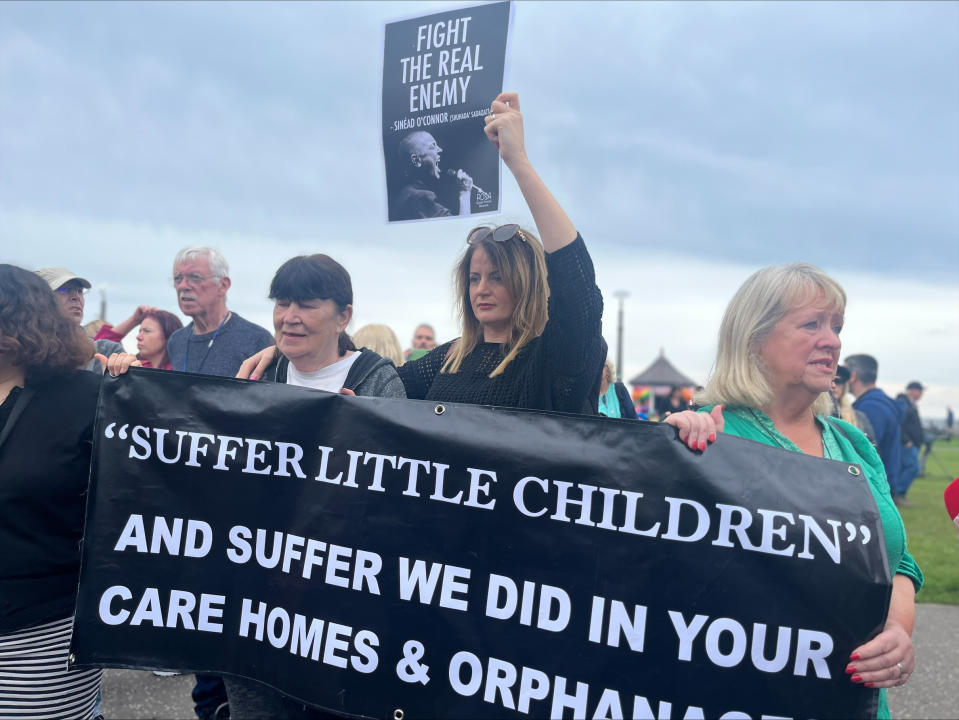Sinead O’Connor ‘gave us strength’, says Magdalene laundry survivor

A woman who suffered abuse in one of the same institutions as Sinead O’Connor said the singer “made Ireland a different place” by speaking out on church and state exploitation.
O’Connor spoke openly about abuse she faced in a Magdalene laundry as a teenager, where she spent more than a year.
A guard of honour was made for the late singer by survivors as her funeral procession passed by her former Irish home.
Magdalene laundries were institutions established by the Catholic Church in Ireland to house “fallen women”.
An estimated 30,000 women were confined in Magdalene laundries and revelations about the widespread abuse of women and girls in the laundries eventually led to a formal state apology in 2013.
Maureen Sullivan, who came to see the funeral procession of O’Connor pass through Bray, Co Wicklow, said she was one of the thousands of women incarcerated in the secretive institutions.
She said she was put into the laundry at age 12 after being abused by a family member.
“I’m a survivor of the Magdalene laundry … and I done four years in these places, trafficked from one to the other,” she said.
“My name changed, my education was taken from me and I wasn’t allowed to play with other children in case I told them what happened to me.”
In 2022, a Journey Stone was unveiled by survivors of the Magdalene Laundries at St Stephen’s Green in Dublin.

The Journey Stone memorial was designed to commemorate the suffering of the women who were incarcerated in Magdalene laundries and similar institutions.
Ms Sullivan said O’Connor was integral to bringing the memorial to fruition.
She said: “Sinead came along, she done a charity single for us so we could get a monument. So, the monument was just thrown on the side, so I decided that I’d turn it into a Journey Stone, and it’s in the little museum in St Stephen’s Green.
“Sinead’s name never comes up much on that, but only for Sinead that Journey Stone wouldn’t be there today.
“It was for all survivors and she was very happy about that.”
Some of those gathered at the funeral held signs highlighting the exploitation that many children faced in church and state institutions in Ireland.
O’Connor ignited vitriol when she tore up a picture of Pope John Paul II on Saturday Night Live in 1992, in protest against sexual and physical abuse in the Catholic Church.
Years following the performance, Pope John Paul II would acknowledge that abuse had been happening in Catholic institutions across the world.
Ms Sullivan said O’Connor highlighting the problem so publicly in the face of such intense backlash gave survivors strength.
“It gave us all courage, it gave us all strength. She gave strength to so many women,” she said.
“And the only thing I feel so sad about was the way she was treated in Ireland, I think that people should have supported her more.”

She added: “They’re supporting her now when she’s dead, but what support did she get when she was living? That’s the sad side of it.
“So my hope for her is that she has gone into the light, and I hope she’s in a better place because she deserves it.
“She made Ireland a different place. She spoke out when nobody else would. She was before her time.”
Ms Sullivan said O’Connor was a once-in-a-generation performer and activist.
“One in a million, I don’t think we’ll ever meet anything like her again,” she said.
She added: “I’ll miss her terribly, I wish somebody would have reached out to her and helped her.”
Mother and Baby home advocate Laura Murphy said she estimated about 100 people who had been affected by the Catholic Church had travelled to honour O’Connor on Tuesday in Bray.
Ms Murphy, 43, from Laois, talked about how the late singer was “not afraid” to speak of her own trauma and had to endure a “horrendous” time after ripping up the picture of the pope.
She said: “So we, in Ireland, the activist movement in Ireland, in general, looks up to Sinead O’Connor as our queen.
“We will honour her from this moment forth in every, every piece of activism we do, every word of truth that we speak, we will be honouring her and we will be emboldened by her, and we will be very cognizant to ensure that her legacy continues.”

 Yahoo News
Yahoo News 
